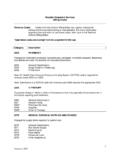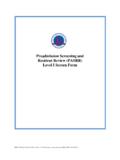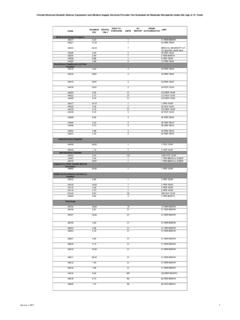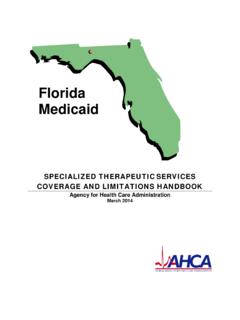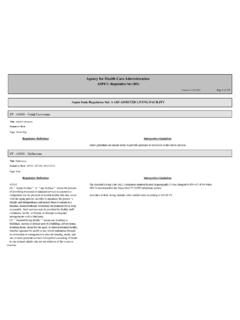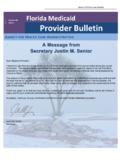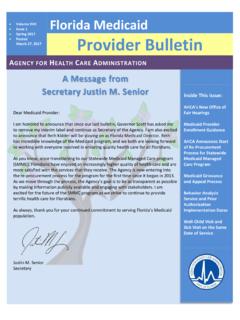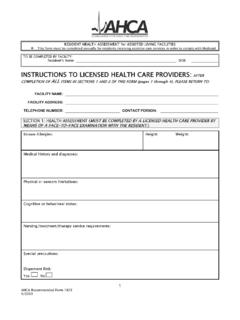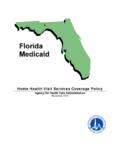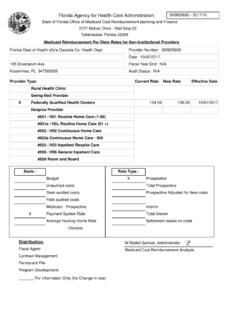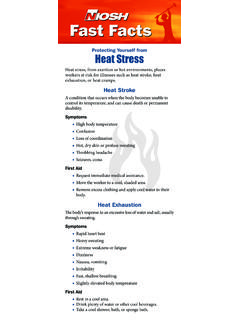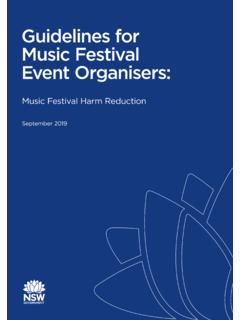Transcription of Surveyor Guidance for Identified Excessively Hot Tap …
1 Surveyor Guidance for Identified Excessively Hot Tap Water Temperatures That May Cause Scald Burns in Health Care Facilities Overview Introduction This protocol establishes procedures for surveyors to follow when they identify Excessively hot tap water temperatures in sinks and bathing facilities, that may cause scald burns of those persons who receive services in all regulated health care and programs. In This Document This document contains: TOPIC PAGE Background 1 Population at Risk 3 Definition of a Burn 4 Procedures 7 Responsibilities 13 References 14 Attachment A.
2 Thermometer Calibration 15 Background Recently, Centers for Medicare and Medicaid Services (CMS), Region IV reviewed some cases in which survey teams Identified Excessively hot water in nursing homes. The following were legal issues/considerations that precipitated from this review: 1. The water possibly was not as hot as the surveyors thought. The surveyors failed to measure the hot water temperature with a thermometer and/or failed to ensure that the thermometer was properly calibrated. 2. Although the Surveyor determined that the water was too hot, it may not necessarily cause harm. The surveyors failed to ensure that all points of contact with the hot water by persons receiving services were investigated. January 2002 Surveyor Guidance For Identified Excessively Hot Tap Water Temperatures That May Cause Scald Burns In Health Care Facilities 3.
3 The elderly have special concerns that must be considered beyond the time/temperature contact with Excessively hot water. This protocol is to assist survey staff in assuring that these issues are addressed in a consistent manner, in any regulated facility/program in which potentially hazardous hot water temperatures are Identified . Typically, the regulations for most federally certified facilities do not include specific required hot water temperatures; however, the regulations address that the facility/provider must ensure the environmental safety of the persons receiving services. There is information available regarding the time/temperature relationship of contact with hot water that can be used as Guidance to determine the seriousness of threat of injury to the persons receiving services. The following are some regulatory requirements for hot water in health care facilities (this is not all inclusive).
4 Facility Federal Requirement State Requirement Temperature ICF/MR Yes None Not to exceed 110 F Nursing Home None Yes 105 F to 115 F Adult Day Care N/A Yes 105 F to 115 F Hospital None Yes Not to exceed 120 F ALF* N/A Yes Not to exceed 120 F AFCH* N/A Yes Not to exceed 120 F RTF* N/A Yes Not to exceed 120 F CSU* N/A Yes Not to exceed 120 F *These facilities are included in Community Based Residential Facilities rule, 64E-12, which is enforced by the Department of Health.
5 According to the 2000 American Burn Association Burn Awareness Week Campaign, scald burns are preventable. Young children, older adults and people with disabilities are most vulnerable to this type of injury. Most burn injuries happen in the home with tap water scalds occurring in the bathroom or other bathing areas. Other scalds relating to preparation or serving of food January 2002 2 Surveyor Guidance for Identified Hot Tap Water Temperatures which may cause Scald burns in Health Care Facilities occur in the kitchen. The severity of injury with scalds depends on two factors: The temperature to which the skin is exposed, and The length of time that the hot liquid is in contact with the skin. At 120 degrees Fahrenheit / 48 degrees Celsius, the recommended temperature setting for home water heaters, skin requires five minutes of exposure for a full thickness burn to occur.
6 When the temperature of a hot liquid is increased to 140 F / 60 C. it takes only five seconds or less for a serious burn to occur1. Coffee, tea, hot chocolate and other hot beverages are usually served at 160 to 180 F. / 71-82 C. degrees, resulting in almost instantaneous burns that require surgery to heal. Immediate removal of the hot liquid from the skin may lessen severity, therefore splash and spill burns may not be as deep as burns to someone who falls into a bathtub. 1 Moritz, , Herriques, Jr. Studies of thermal injuries: II The relative importance of time and surface temperature in the causation of cutaneous burn. Am J Pathol 1947; 23:695-720. High Risk Population for Scald Burns Although anyone can be affected by scalds, certain people are at increased risk. These high risk groups include infants and young children, older adults and people with any type of disability.
7 Males are about twice as likely to be scalded as females in all age groups. Older Adults Older adults, like young children, have thinner skin so hot liquids cause deeper burns with even brief exposure. Their ability to feel heat may be decreased due to certain medical conditions or medications so they may not realize water is too hot until injury has occurred. Older adults may also have conditions that make them more prone to falls in the bathtub or shower or while carrying hot liquids. People With Disabilities or Special Needs Individuals who may have physical, mental or emotional challenges or require some type of assistance from caregivers are at high risk for all types of burn injuries including scalds. The disability may be permanent or temporary due to illness or injury and vary in severity from minor to total dependency on others. Mobility impairments, slow or awkward movements, muscle weakness or fatigue, or slower reflexes increase the risk of spills while moving hot liquids.
8 Burns to the lap are common when a person attempts to carry hot liquids or food while seated in a wheelchair. Moving hot liquids can be extremely difficult for someone who uses a cane or walker. Sensory impairments can result in decreased sensation, especially to the hands and feet, so the person may not realize if something is too hot. Changes in a person s intellect, perception, memory, judgment or awareness may hinder the person s ability to recognize a dangerous situation (such as a tub filled with scalding water) or respond appropriately to remove his or herself from danger. January 20021 3 Surveyor Guidance For Identified Excessively Hot Tap Water Temperatures That May Cause Scald Burns In Health Care Facilities While the principles of scald prevention that apply to the general population also apply to this high risk group, there are additional concerns that must be addressed.
9 Scald injuries result in considerable pain, prolonged treatment, possible lifelong scarring, and even death. The number of deaths from scalds is 100 annually in all age groups. Tap water scalds are often more severe than cooking-related scalds. Nationwide, tap water scalds result in more inpatient hospitalizations, generally cover a larger percent of the person s body, and result in more fatalities than other types of scalds5. For additional information relating to burn prevention, contact the American Burn Association at 800-548-2876 or Compiled by P. Brigham, Burn Foundation, Allentown, PA, 1999. Sources: National Health Interview Survey, National Hospital Discharge Survey, National Hospital AmbulatoryMedical Care Survey, National Electronic Injury Surveillance System. Young, M., Manara, A & Burd, D. (1995) Intensive care management of the child with severe burns.
10 Care of the Critically Ill. May-June, 11(3); 93-7. Definition of a Cutaneous Burn A burn is damage to the skin and underlying tissue caused by heat, chemicals or electricity a very simplistic definition for a very complex injury. Burns damage or destroy the skin cells. Deeper burns may involve the fat, muscle or bone. Scalds result from the destruction of one or more layers of the skin due to contact with hot liquids or steam. The temperature to which the skin is exposed and the length of time the skin is exposed to the burning substance determine the depth of injury. Burns range is severity from minor injuries that require no medical treatment to serious, life-threatening and fatal injuries. Burns are categorized in terms of degrees, which are described below. Partial thickness injuries include first and second degree burns; full thickness injuries encompass third degree and deeper burns.
